This oven baked Nigerian jollof rice is sensational! Jollof rice is a West African staple consisting of rice cooked in a delicious, flavour-packed and often spicy tomato sauce. Though it seems simple enough to make, it’s actually pretty difficult to nail. From burning your jollof and making it bitter, to accidentally turning the rice to mush, there are so many things that can go wrong. Oven baked jollof rice isn’t traditional by any means. That said, it’s the most foolproof method I’ve found for nailing jollof rice every single time.
Note: This recipe was first posted on 12 March 2024. It was updated on 4 September 2024 with new images – the recipe remains the same.
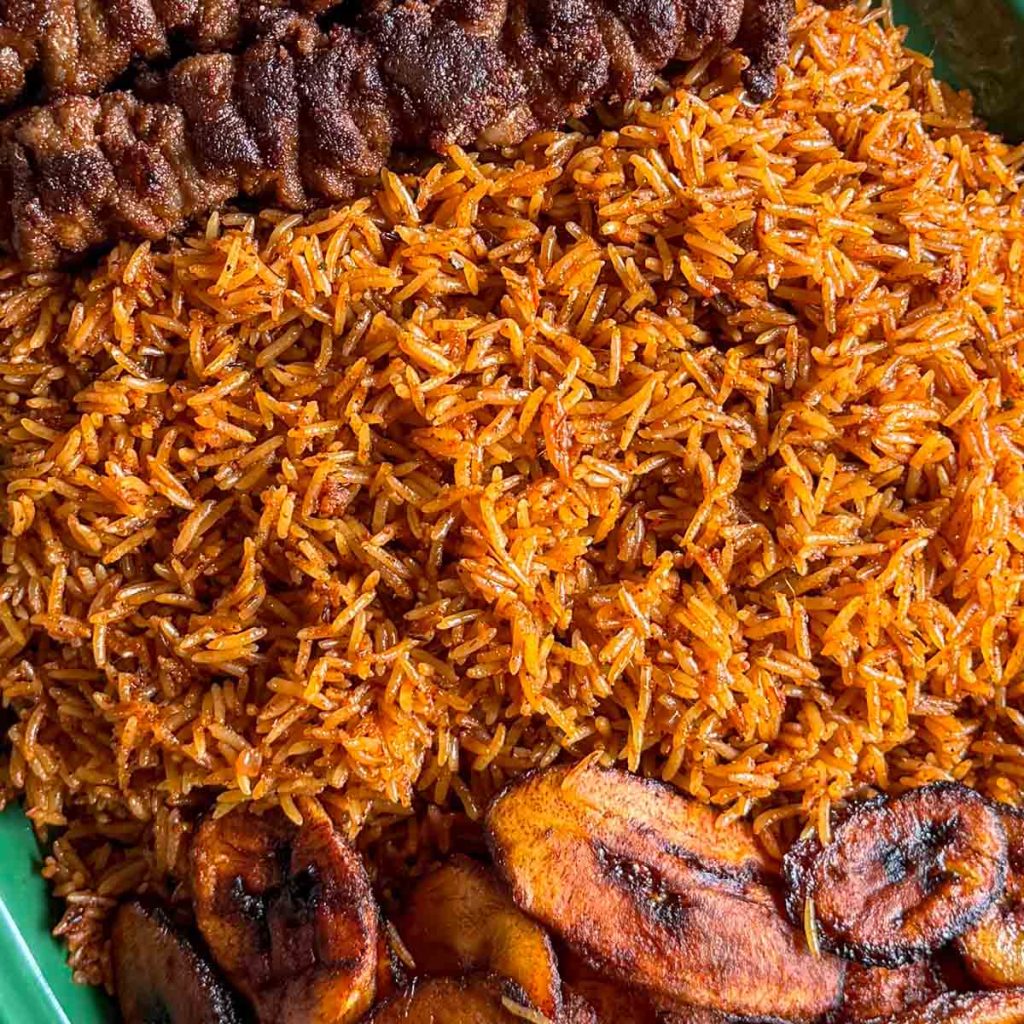
Key Ingredients
Jollof rice varies from family to family. For me, a good Nigerian jollof rice must have:
- Tomatoes: ripe red vine tomatoes work best.
- Red bell pepper: it adds a very subtle sweetness that tames the natural acidity of the tomatoes.
- Scotch bonnet: it doesn’t just add heat, it also contributes to the taste that characterises authentic jollof rice.
- Onion: I’m partial to red onions but white/brown onions are fine, too.
- Double concentrated tomato purée: this is what gives jollof rice its reddish hue. Additionally, its natural sugars caramelise as they cook, which adds a subtle sweetness that balances the savoury elements of jollof rice.
- Rice: I’m partial to long-grain parboiled rice as it has the ability to absorb flavours while maintaining a firm texture. High-quality basmati rice works very well, too. More on that below.
- Key seasonings: ginger, curry powder, dried thyme, bay leaves and stock cubes form the savoury backbone of jollof rice. Some people add garlic. Though I’m a garlic girl, I don’t think it belongs in jollof rice – I get that from my grandmother and her sisters.
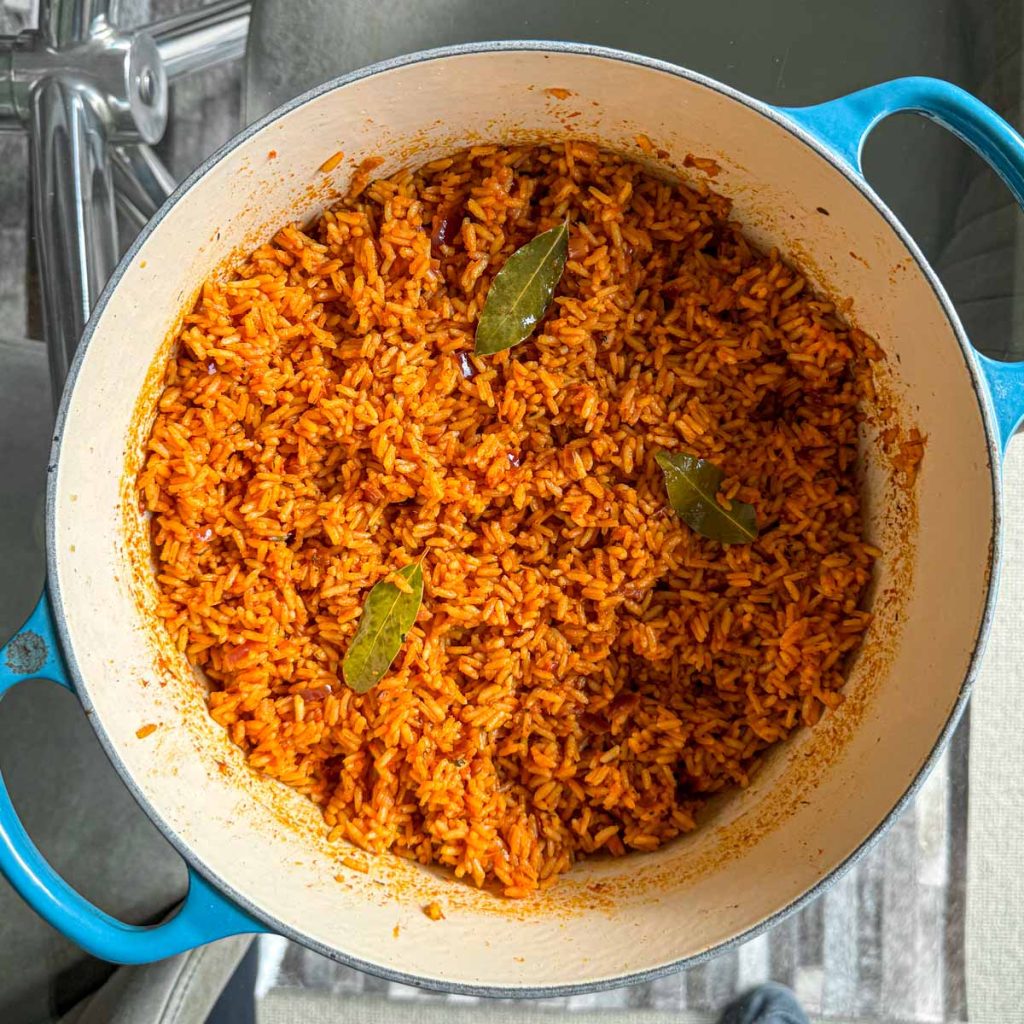
The Best Rice for Oven Baked Jollof Rice?
Choosing the right type of rice is crucial to achieving the perfect jollof rice. In my experience, parboiled long-grain rice is the best choice. I typically use Uncle Ben’s, now rebranded as Ben’s Original, for its unique texture and cooking qualities. Parboiled rice undergoes a process where the grains are partially boiled in the husk. This only gives the rice a firmer texture, which is perfect for jollof rice. It also ensures that each grain remains separate and fluffy. Even after absorbing all the rich flavours of the tomato sauce! The result is a pot of oven baked jollof rice with perfectly separate grains that are tender but not mushy.
While parboiled long-grain rice is ideal, basmati rice can also work well in jollof. The key is choosing a high-quality variety like Golden Sella. Golden Sella basmati rice is parboiled, similar to the long-grain rice. This means it also holds its shape well during cooking. Its slightly nutty flavour and fragrance add another layer of complexity to the oven baked jollof rice, enhancing the dish without overpowering the traditional taste.
Both types of rice offer unique benefits, so it comes down to personal preference. If you love a firm, fluffy texture that holds up well to the robust, spicy flavours of jollof, go for parboiled long-grain rice. If you’re looking for a slightly more aromatic and delicate grain, high-quality basmati like Golden Sella is a fantastic option. Whichever you choose, remember that quality rice is key to making the best oven baked jollof rice every single time.
For visual reference, here’s a video of me making this Oven Baked Jollof rice with leg grain rice, and here’s one of me making it with basmati rice.
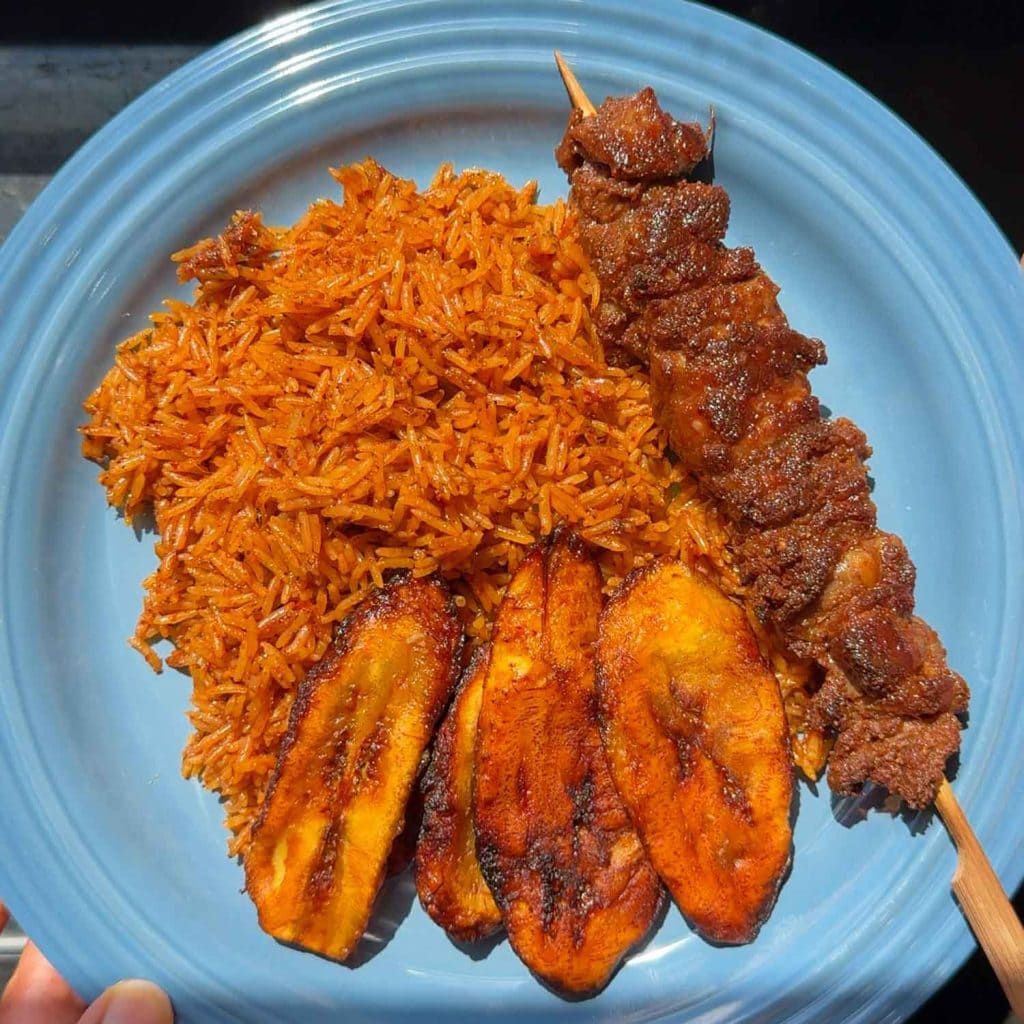
Oven vs. Stove: The Best Method for Making Jollof Rice
Traditionally, you cook jollof rice over firewood or on the hob. In both these methods, all of the heat comes through the base of the pot and it makes its way up through the rice. This uneven heat distribution can burn the jollof rice or make it mushy on the bottom. Now, some level of burning is good, as it creates a caramelised, roasted bottom that adds smokiness to the finished jollof rice. However, there’s a very fine line between smoky jollof and straight up burnt jollof, and achieving the former requires meticulous attention to detail and careful temperature management.
The oven-baked method takes out most of the guesswork. It offers a hands-off approach, making it easier to consistently nail jollof rice without the need for constant stirring and monitoring. Unlike the hob method, the oven’s radiant heat envelops the entire pot, ensuring even heat distribution. This minimises the risk of the rice sticking to the bottom of the pot or of any burnt spots forming.
The Science Behind the Oven Baking Jollof Rice
One of the most fascinating things about oven-baked jollof rice is how much more forgiving it is relative to the stovetop method. This comes down to how heat behaves in the oven versus a hob. On the stove, the heat comes from the base of the pot. Unless you’re stirring frequently and adjusting the flame as you go, it’s easy for the bottom layer to overcook or burn while the top stays underdone. This is especially risky with jollof, where the sauce is thick and the rice needs time to steam through.
The oven, on the other hand, distributes heat more evenly around the pot. Rather than blasting the bottom layer, the ambient heat gently cooks the rice from all sides. This creates a more uniform texture, helping each grain absorb flavour slowly and consistently. It also allows you to control moisture levels more precisely. With the pot tightly covered—ideally with foil and a lid—steam is trapped inside, which simmers the rice in a sealed environment. It’s this even, enclosed heat that allows the rice to cook through without needing to stir or check obsessively.
For those new to jollof or tired of uneven results, this method takes out much of the stress. You don’t need to babysit the pot or worry about whether you’ve added too much water. As long as your sauce is rich and concentrated, and you’ve sealed your pot well, the oven does the heavy lifting for you.
Making Smoky Jollof Rice Without Any Burning
As I mentioned above, one of the benefits of cooking jollof rice on the stove or over firewood is the charred, caramelised layer of rice at the bottom of the pot, which adds a lovely smoky note to the finished jollof rice. But as I also mentioned, the fine line between smoky jollof and burnt, bitter jollof can be very hard to navigate.
The oven method enables you to add smokiness to your jollof rice without any burning. You achieve this roasting the vegetables that make up the stew base. For context, traditionally, tomatoes, bell peppers and scotch bonnet chillies are blended, boiled down and seasoned before the rice is added. Roasting the vegetables beforehand does two things. First, it concentrates their flavour without the hassle – anyone who’s ever made Nigerian stew will know just how messy it can be (it splatters everywhere!). Second, and perhaps more importantly, roasting the vegetables creates caramelised, charred edges that mimic the smoky flavour you’d get from burning the bottom of your jollof rice on the hob.
If you’d prefer a stovetop jollof rice, why note try My Mum’s Jollof Rice. Whether it’s oven-baked or cooked on the hob, I recommend serving your jollof rice with suya and fried plantain.
Oven-Baked Jollof Rice
5 Stars 4 Stars 3 Stars 2 Stars 1 Star
5 from 3 reviews
Jollof rice is a West African staple consisting of rice cooked in a delicious, flavour-packed and often spicy tomato sauce. Though it seems simple enough to make, it’s actually pretty difficult to nail. From burning your jollof and making it bitter, to accidentally turning the rice to mush, there are so many things that can go wrong. Oven baking jollof rice isn’t traditional by any means. That said, it’s the most foolproof method I’ve found for nailing jollof rice every single time.
- Author: zenak
- Prep Time: 20 minutes
- Total Time: 2 hours
- Yield: 8 with leftovers 1x
Ingredients
For the stew base:
- 4 medium vine tomatoes, halved and deseeded
- 1 red bell pepper, cut into large chunks
- 1 onion, cut into large chunks
- 1 red scotch bonnet chilli, stem removed (see Notes)
- 1 tbsp vegetable oil (or any neutral oil)
- 15g fresh ginger, peeled and roughly chopped
- 1 tsp fine sea salt
For the jollof rice:
- 600g parboiled long-grain rice (I use Ben’s Original) or high-quality basmati rice (e.g. Golden Sella Basmati Rice)
- 150ml vegetable oil (or any neutral oil)
- 1 onion, finely chopped
- 60g double concentrated tomato purée
- 1 tbsp curry powder (mild, medium or hot, as preferred)
- 1 tbsp dried thyme
- 3 chicken or vegetable stock cubes
- 2 dried bay leaves
- 600ml boiling water
Instructions
- Heat your oven to 220℃ / fan 200℃.
- Place the tomatoes, red bell pepper, onion and scotch bonnet on a medium roasting tin. Add the vegetable oil, toss to coat. Roast for 25 to 30 minutes, or until the vegetables are softened and charred at the edges.
- Leave to cool for 10 minutes and turn the oven down to 180℃ / fan 160℃.
- Transfer the roasted vegetables to a blender. Add the fresh ginger and salt and blitz until smooth. Set aside.
- Thoroughly wash the long-grain rice with cold water until the water runs clear, then drain. Please don’t rush this step. The goal is to remove as much of the starch as possible, which is what is going to give you separate, non-sticky cooked grains of rice. Leave to drain in a sieve until ready to use.
- Heat the vegetable oil in a large Dutch oven set over a medium heat. Add the onion and cook, stirring occasionally, until softened and beginning to brown, 6 to 8 minutes.
- Add the double concentrated tomato purée and cook, stirring frequently, until it begins to darken, 3 to 5 minutes.
- Add the blended stew, stir to combine, partially cover the pot with the lid and bring to a simmer. Cook, stirring occasionally, until the oil separates from the stew, around 5 minutes.
- Add the curry powder and dried thyme and cook, stirring almost constantly for 1 minute, then add the stock cubes, bay leaves and water. Whisk well to dissolve the stock cubes.
- Add the washed and drained rice and stir to combine. Taste and adjust the salt level to your liking – the liquid should be well-seasoned.
- Once the rice begins to gurgle, cover with the lid and transfer the Dutch oven to the oven. Bake for 45 minutes.
- If you don’t have a Dutch oven, transfer the contents of the pot to a large, deep roasting tin. Add an extra 50ml of boiling water, cover very tightly with 3 layers of foil and bake for 45 minutes.
- Remove the pot from the oven and leave it covered for 15 minutes – the steam will finish cooking the rice.
- Remove the bay leaves, give the rice a stir and you’re ready to serve, preferably with grilled chicken and fried plantain – enjoy!
Notes
I generally use 2 scotch bonnets, which yields what I would call a spicy jollof rice. For a mild jollof rice, use ½. For a medium jollof rice, use 1. For a blow-your-head-off spicy jollof rice, use 3 or more (at your own risk!)

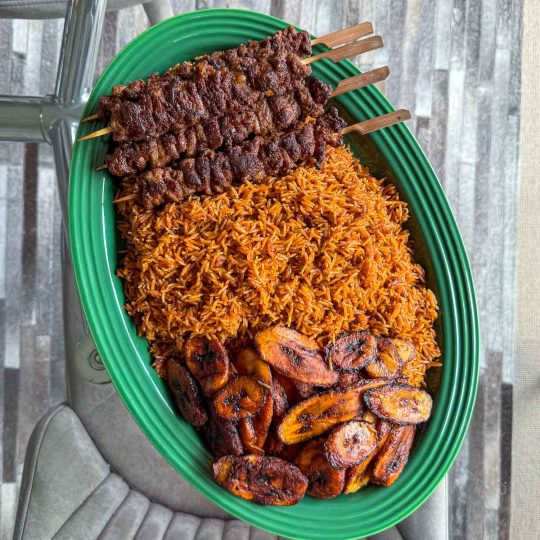

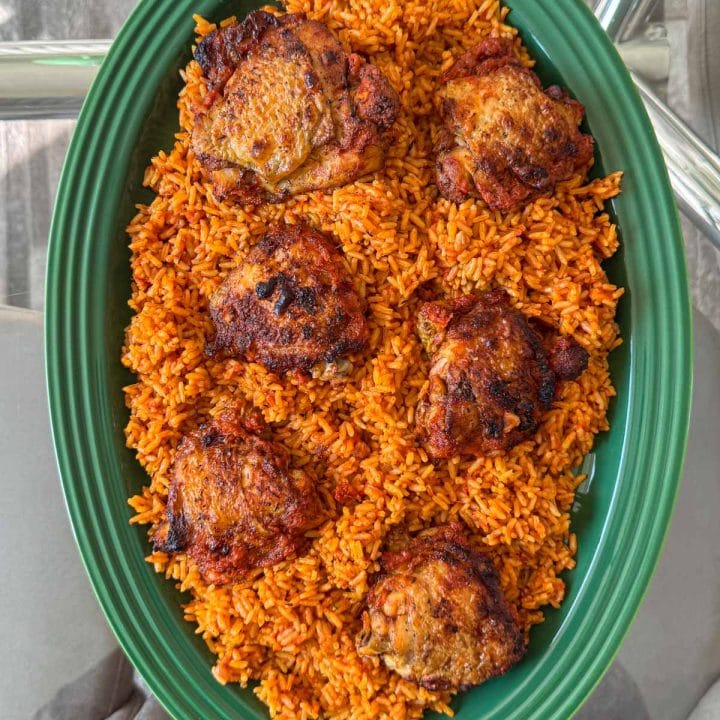



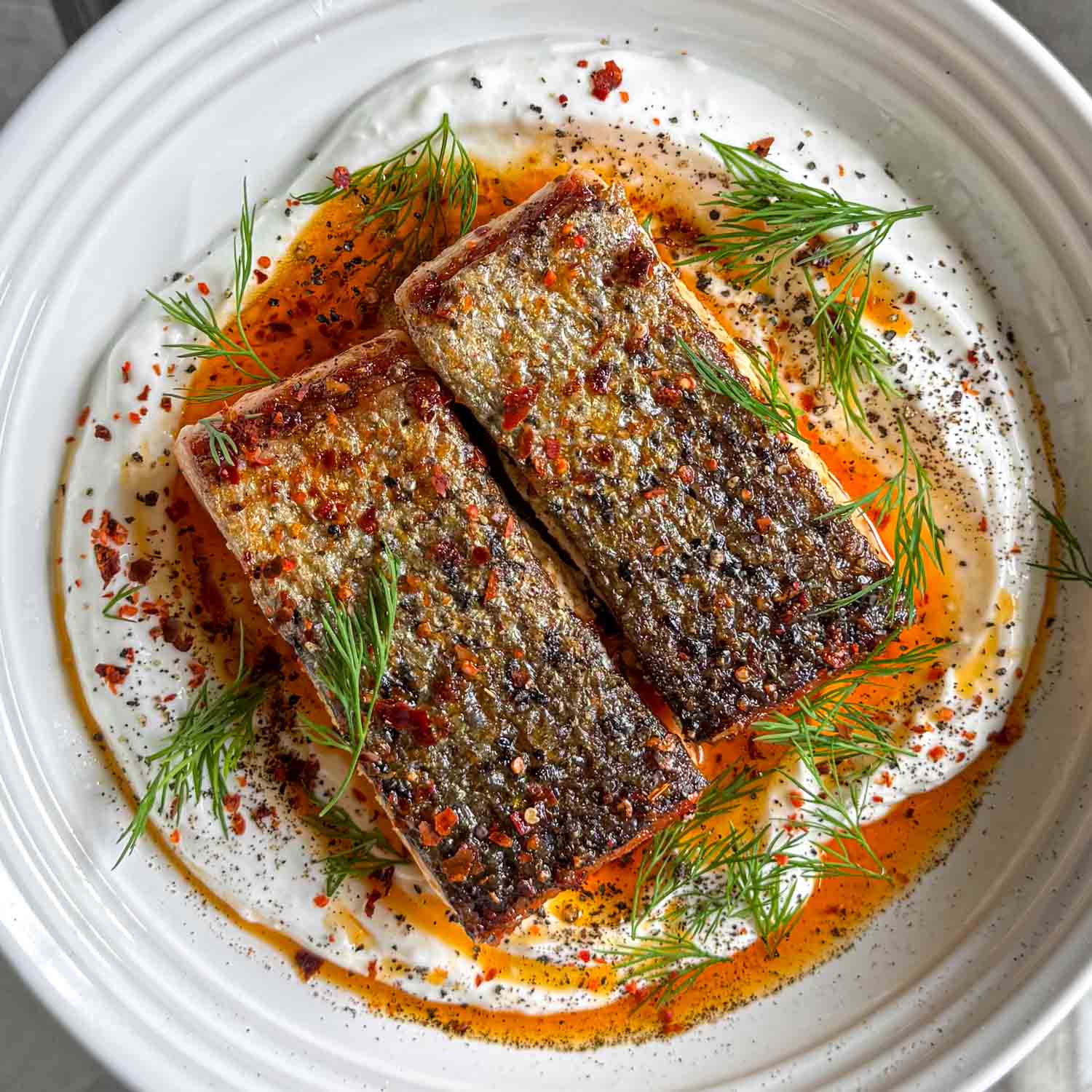
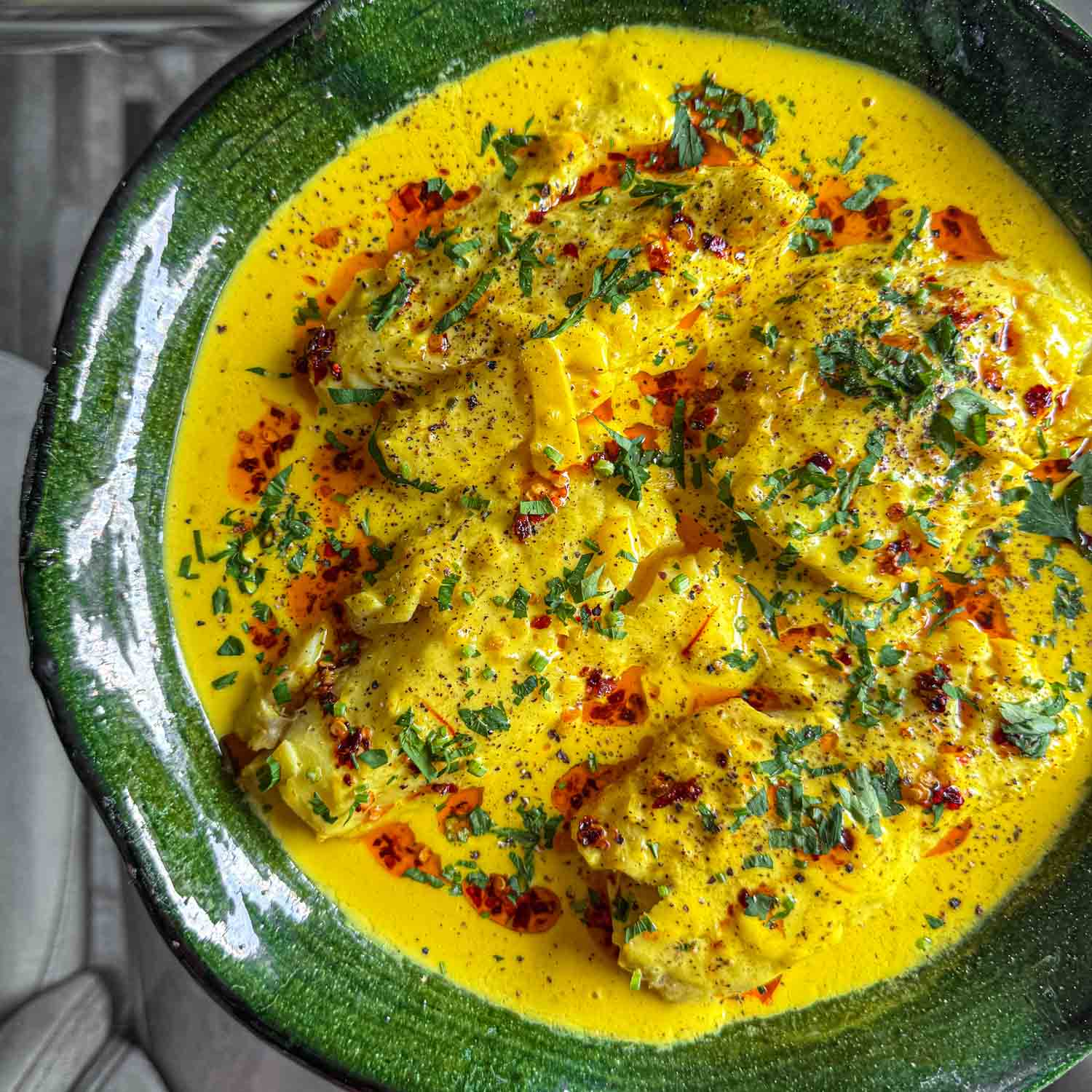
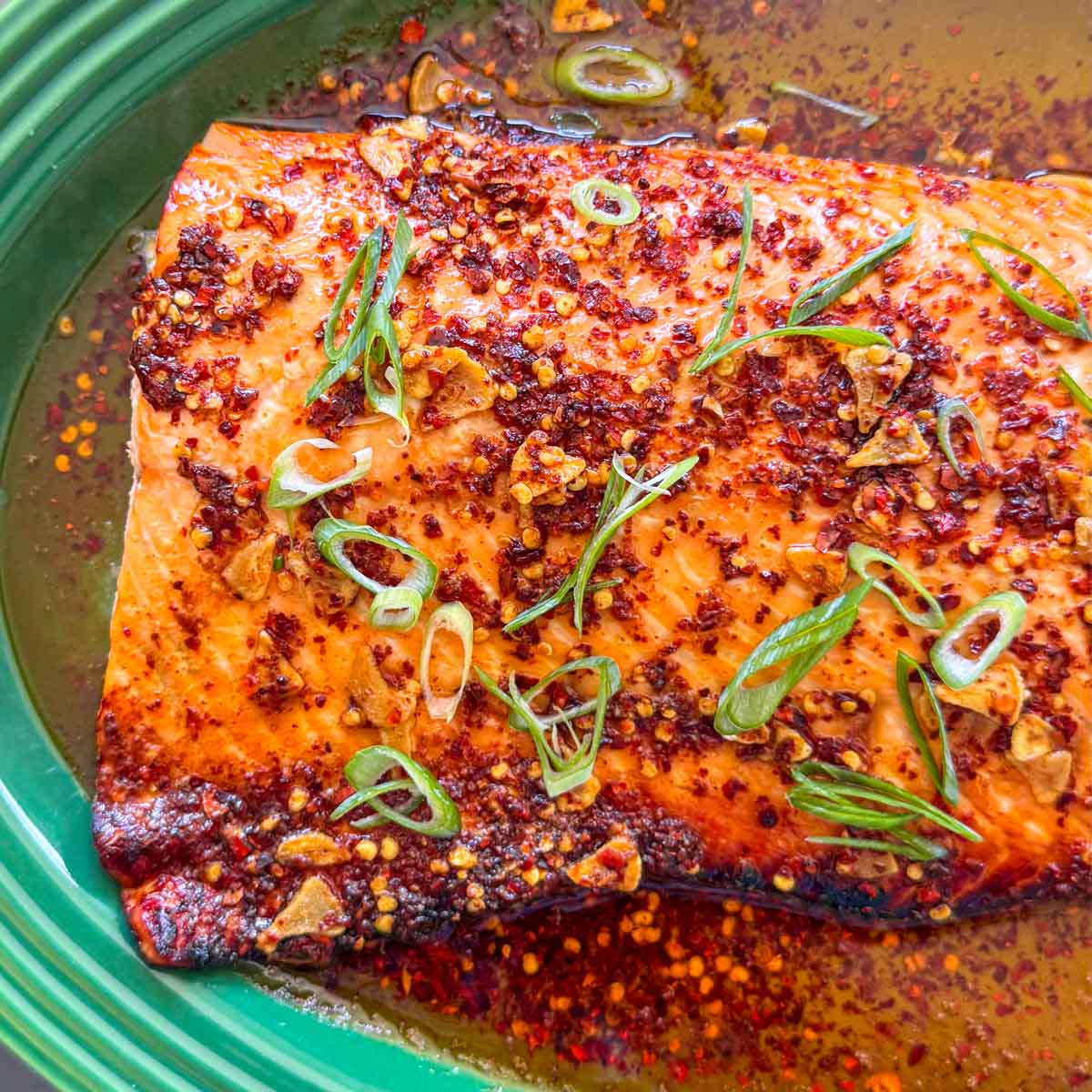
34 responses
this was really delicious! unfortunately i was unable to find scotch bonnet at the grocery store and had to use habanero but that still worked well.
had coleslaw and chicken on the side and really enjoyed this meal. thanks for sharing it!
It’s my absolute pleasure! I’m so glad you enjoyed it 🙂
Hey, I want to try this! I have a quick question…. Once the stew and oil has separated, am I spooning off the oil? Or is the separation just a point of “heads up, I’m ready, time for the next step”?
It’s the latter – a heads up! Though you can spoon some off if you’d like!
Awesome, thanks!
Made this and added some spot prawns. Delicious!
Oooh love the sound of that!
Delicious, only change I made was searing chicken before cooking onions and then adding it after the rice begins to boil before putting it in the oven. To accommodate the chicken soaking up some of the water I added an extra 100-150ml of water. Comes out perfect everytime!
Sounds delicious! I do that sometimes too 🙂
Can I ask at what point the 600ml water is added?
In Step 9, along with the stock cubes and bay leaves 🙂
Oops missed that, thank you! Excellent recipe!
My pleasure! Thank you for kind words 🙂
Is there any change to cooking time if you use regular (non-parboiled) rice?
I’ve not tested it with non-parboiled rice but to be honest, most supermarket long grain rice is parboiled, even if it doesn’t explicitly say so on the packaging. If you’re absolutely sure it it’s parboiled, I’d add 10 minutes to the oven time 🙂
Fantastic recipe!
So easy and tastes delicious
Thank you so much! I’m so glad you enjoyed it 🙂
OMG 😊 seems easier that my unsuccessful attempts at jollof rice. Love your presentation style. I saved this recipe to try later. Thank you!
Thank you so much! I hope it’s a great success when you do 🙂
In the process of making this right now! Will report back!
Love it love it love it! Thank you so much for the recipe! Everyone go make it, come on!
Thank you so much for the positive feedback! It’s greatly appreciated 🙂
Is the double concentrated tomato purée the same as tomato paste?
No, double concentrated tomato purée is more concentrated than regular tomato paste 🙂
What heat level did you use for baking the rice?
180C / fan 160C. It’s mentioned in step 3 but it might be worth me mentioning it in step 11 too!
The best rice I’ve even eaten. Received so many compliments over this recipe. Will definitely be a staple in my household now.
This means so much, thank you 🙂 I’m so glad you all enjoyed it!
Great recipe!!! The instructions are very easy to follow. I appreciate you sharing your culture with a renewed twist. My kids love it. Thank you.
Thank you so much! It’s my absolute pleasure 🙂
This is officially my go-to jollof recipe because it comes out perfect every single time! Thank you Zena!!
Yay! I’m so happy to hear it!
I’ve been looking for a Jollof rice recipe and this one was so easy to prepare and follow. My other inspiration was I also love spicy food and I have a Nigerian uncle by marriage! I’m very familiar with this rice and wanted to try it. I used brown rice 😋🤩
I’m so happy to hear it! Also, great to know that it works with brown rice 🙂